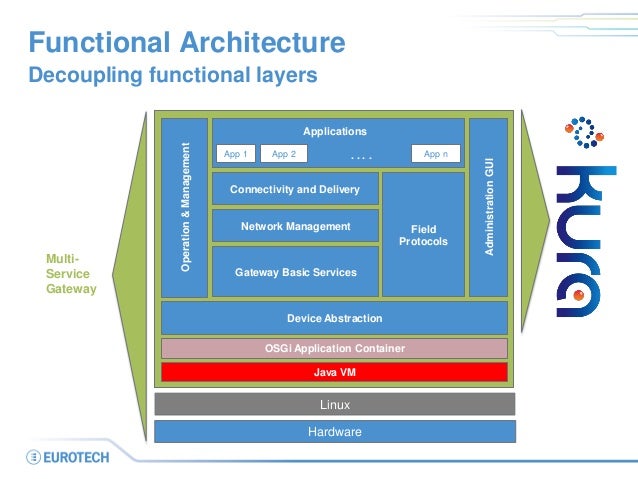This is repost of my DZone article - Creating Camel routes for Eclipse Kura.
Eclipse Kura is the Open Source M2M Software Framework of choice for IoT Gateways, and it's well known for its ease of use and flexibility, and Apache Camel is a message routing engine providing out of the box dozens of connectors to different endpoints.
Eclipse Kura and Apache Camel, when joined together, give developers the possibility to abstract their application logic from both field protocols and data delivery, thus easing and speeding up the development process.
Rhiot Kura Camel quickstart can be used to create Camel router OSGi bundle project deployable into the Eclipse Kura gateway. Rhiot supports Kura gateway deployments as a first class citizen and this quickstart is intended to be used as a blueprint for Camel deployments for Kura. Under the hood Rhiot quickstart uses Camel Kura component to leverage an integration between Kura and Camel .
If you are wondering where Kura Camel project fits into the Kura architecture - our quickstart is deployed into the application layer of Kura, with a dedicated Camel context instance per application bundle.
Creating a Kura Camel project
In order to create the Kura Camel project from Rhiot quickstart execute the following commands:
git clone git@github.com:rhiot/quickstarts.git
cp -r quickstarts/kura-camel kura-camel
cd kura-camel
mvn install
Prerequisites
We presume that you have Eclipse Kura already installed on your target device. And that you know the IP address of that device. If you happen to deploy to a Raspbian-based device, and you would like to find the IP of that Raspberry Pi device connected to your local network, you can use the Rhiot device scanner, as demonstrated on the snippet below:
docker run --net=host -it rhiot/deploy-gateway scan
The command above will return an output similar to the one presented below:
Scanning local networks for devices...
======================================
Device type IPv4 address
--------------------------------------
RaspberryPi2 /192.168.1.100
Keep in mind that /opt/eclipse/kura/kura/config.ini file on your target device should have OSGi boot delegation enabled for packages sun.*,com.sun.*. Your /opt/eclipse/kura/kura/config.ini should contain the following line then:
org.osgi.framework.bootdelegation=sun.*,com.sun.*
A boot delegation of sun packages is required to make Camel work smoothly in an Equinox.
Deployment
In order to deploy Camel application to a Kura server, you have to copy necessary Camel jars and a bundle containing your application. Your bundle can be deployed into the target device by executing an scp command. For example:
scp target/rhiot-kura-camel-1.0.0-SNAPSHOT.jar pi@192.168.1.100:/tmp
The command above will copy your bundle to the /tmp/rhiot-kura-camel-1.0.0-SNAPSHOT.jar location on a target device. Use similar scp command to deploy Camel jars required to run your project:
scp ~/.m2/repository/org/apache/camel/camel-core/2.16.0/camel-core-2.16.0.jar pi@192.168.1.100:/tmp
scp ~/.m2/repository/org/apache/camel/camel-core-osgi/2.16.0/camel-core-osgi-2.16.0.jar pi@192.168.1.100:/tmp
scp ~/.m2/repository/org/apache/camel/camel-kura/2.16.0/camel-kura-2.16.0.jar pi@192.168.1.100:/tmp
Now log into your target device Kura shell using telnet:
telnet localhost 5002
And install the bundles you previously scp-ed:
install file:///tmp/camel-core-2.16.0.jar
install file:///tmp/camel-core-osgi-2.16.0.jar
install file:///tmp/camel-kura-2.16.0.jar
install file:///tmp/rhiot-kura-camel-1.0.0-SNAPSHOT.jar
Finally start your application using the following command:
start
Keep in mind that bundles you deployed using the recipe above are not installed permanently and will be reverted after the server restart. Please read Kura documentation for more details regarding
permanent deployments.
What the quickstart is actually doing?
This quickstart triggers
Camel timer event every second and sends it to the system logger using
Camel Log component. This is fairy simple functionality, but enough to demonstrate the Camel Kura project is actually working and processing messages.
The snippet below demonstrates the code of the route:
public class GatewayRouter extends KuraRouter {
@Override public void configure() throws Exception {
from("timer://heartbeat").
to("log:heartbeat");
}
...
}
If you are curious how can you create more complicated routes connected to Kura internal services, you would be interested in incoming articles demonstrating those features.







